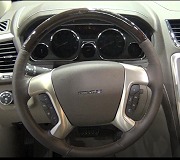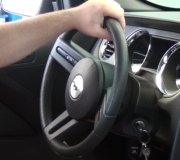Head straight to a tire and alignment shop to have the steering and suspension systems inspected right away. You're fortunate that this is a '90s model Mazda product. The Escorts and Tempos from the '80s were called "killer cars" because of the huge problem they had with steering parts separating leading to loss of control and crashes. That occurred in as little as 15,000 miles. Yours is not a Ford-built car but you still must never ignore a noise or handling problem.
There are some things that can cause what you described and are not exactly a serious safety issue, (other than the unstable steering response), but to drive with a known problem leaves you open to a lawsuit if you're involved in a crash caused by the other guy. A lawyer will convince a jury you were partly at fault for ignoring a known defect that could have prevented you from avoiding the crash. I have to include that warning to impress how serious this CAN become if you wait too long.
Among the less-serious possible causes, a worn and sloppy strut can allow one front wheel to tip in or out on top. Tires want to roll in the direction they're leaning, so if it shifts position, the car will tend to follow it. A worn lower control arm bushing will let the bottom of the wheel shift in and out, and it can let it move forward or rearward when braking or accelerating. Another thing I've run into before is a loose rack and pinion steering gear assembly. It can't fall off completely, but if it's bad enough, you'll have less steering control than a drunk driver. All of these things typically have a clunking or thumping noise associated with them, but regardless, the alignment specialist shouldn't have any trouble identifying the cause.
The more serious things include a lower ball joint and an inner or outer tie rod end that have excessive wear between their ball and socket. If a ball joint separates, the bottom of that wheel will squirt out and fall backward into the fender and damage the body. Usually the rubber brake hose gets torn off too, and the half shaft will get pulled out of the transmission or get pulled apart. If a tie rod end comes apart, that wheel will turn fully to that side of the car during braking, (which in this case means skidding sideways), or it will turn fully toward the center of the car during acceleration. Either way, you have a 99 percent chance of heading uncontrollably into the ditch or oncoming traffic. This is what was so common with the Escorts and Tempos in the '80s.
Anything that can cause the car to pull and / or steer in an unintended or unexpected direction is affecting the alignment, so the car will need to be aligned once the worn parts are replaced. This was another huge problem with the '80s Ford models. The wheels were factory-set to unbelievably extreme angles to provide a smoother ride than their competitor's cars, but the tires wore out in 15,000 miles. There were aftermarket parts developed to address the problem on the rear wheels and put them where they should have been designed in the first place, but there was no way to fix the design problem on the front. You just had to keep buying tires. There are no known common problems like that with your car. This means that just as with all other car models, tire wear patterns can be "read" by the mechanic to look for clues to alignment problems and worn parts. Tire wear, pulling to one side, and a steering wheel that has shifted from being centered are the three things we look for to identify the need for an alignment. You can observe the last two things every time you drive, but tire wear takes longer to show up.
The off-center steering wheel sounds like what you're seeing, but that is hard to tell when it only occurs while turning. If you see that happening while you're on a straight road, be sure to include that in the list of symptoms you give your mechanic.
Tuesday, April 7th, 2015 AT 7:29 PM



